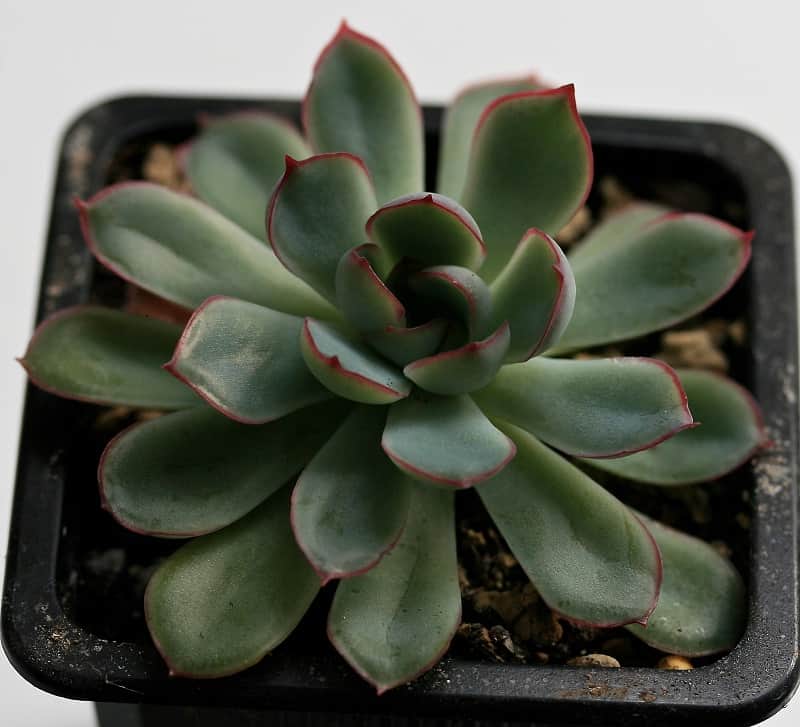Echeveria Pulidonis is a perennial crass plant native to Mexico.
It is a very ornamental succulent plant of slow growth.
It develops forming rosettes of low height, without stem, adult plants can reach about twelve centimeters in diameter.
Its leaves are elongated and curved, shaped like a spoon with a pointed end.
Its leaves are arranged on a central fleshy axis, they are of a beautiful soft bluish-green color and red edges.
It can be grown alone, over time small rosettes will grow at your feet forming very decorative groups.
It blooms in spring the flowers arise in groups at the end of a tall, cylindrical stem of a reddish color, they are bright yellow, the stems lean towards the ground due to the weight of the flowers.
Adult specimens develop several floral stems.
You may like Aloe Arborescens
Tips to take care of the Echeveria Pulidonis
Substratum
Porous and loose soil, it is advisable to use a special substrate for crass plants and cacti that contains river sand and small aggregates in different sizes, to ensure perfect drainage.
Transplant
If necessary, if you want to transplant the plants, you will Moderately water the plants, during spring and summer, try not to wet the leaves especially avoid wetting the center of the rosette to avoid rot, it is recommended that the water goes directly to the ground.
The amount should be moderate and the risks must be distanced waiting for the substrate to dry between them.
Pots
Use a pot of slightly larger size, we will incorporate a substrate of special quality for crass plants, if we have cut dried roots, we will wait a week before watering so that the wounds heal.
If necessary we can add a small amount of special liquid fertilizer for succulent plants, along with the irrigation water, monthly in spring and early summer.
Bright Light and Temperature
Echeveria loves having good lighting.
Plant the echeveria in full sun with halfway shade. This plant will be delighted in this type of environment.
The plant must have good lighting; this way, it will avoid stretching, which encourages redness.
This plant loves the heat of summer.
To maintain healthy growth, try to keep it intemperatures between 10°C and 21°C / 50 ° F and 70 ° F.
It is recommended that you take the echeveria pulidonis indoors during winter, this plant it is not resistant to low temperatures and high winds.
It is a suitable plant for warm winter climates, does not like cold or resists frost.
As temperatures fall there is mos risk for the plant to die.
So make sure to take care of it.
Remove the dried leaves from the base of the plant to keep it healthy and the inflorescences dry.
If the weather is cold or wet it is advisable to grow the plants in pots to be able to protect during cold or rainy times.
It is advisable to use clay pots that perspire better, airing the substrate easily, so we will prevent the roots or neck of the plant from rotting.
If necessary, we will transplant the plants, we will use a pot of slightly larger size, we will incorporate a substrate of special quality for crass plants, if we have cut dried roots, we will wait a week before watering so that the wounds heal.
Propagation
It can be reproduced by seeds but it is a long process to obtain medium plants.
It can be reproduced by separating the small rosettes that grow around it, so we will get plants faster, also by leaf cutting.
The wound on the rosette or the leaf should heal before it is placed on the ground for a week.
When propagating this plant, it is essential to keep in mind the hot and humid climates; in these conditions, it can be attacked by mealybugs.
Its main enemies are intense cold, poor drainage, excessive irrigation or poor aeration.
You have to keep the plants in optimal conditions for good development.
Pest
You will be surprised to know how resistant this plant is, as far as plague is concerned. It is unlikely that you find pets in this succulent.
But it is always important to give it the necessary care to avoid mealybugs.
Allway removes the dead leaves; do in this helps you plant.
And make sure to take the time to inspect your plant for mealybugs, if you see them, remove them with alcohol.
Conclusion
The plant is low growing reaching only 8” inches tall and 6” to 8” inches wide.
Its curved rosettes and its outstanding red colors will always be in your thoughts. And over time, you will be amazed at how beautiful this plant can grow.
Echeveria care is fairly simple.
The #1 care or maintenance item!
Prevent root rot.
Additionally, remove dead leaves at the base of the plant.
They make great hiding places for mealybugs.
Hope this article was helpful.
